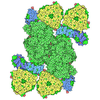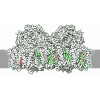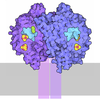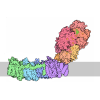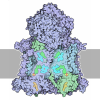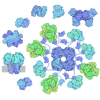+ Open data
Open data
- Basic information
Basic information
| Entry | Database: PDB / ID: 9kc5 | |||||||||||||||||||||||||||
|---|---|---|---|---|---|---|---|---|---|---|---|---|---|---|---|---|---|---|---|---|---|---|---|---|---|---|---|---|
| Title | PSI-LHCI of the red alga Galdieria sulphuraria NIES-3638 | |||||||||||||||||||||||||||
 Components Components |
| |||||||||||||||||||||||||||
 Keywords Keywords | PHOTOSYNTHESIS / Photosystem I / ELECTRON TRANSPORT | |||||||||||||||||||||||||||
| Function / homology |  Function and homology information Function and homology informationplastid thylakoid membrane / thylakoid membrane / photosynthesis, light harvesting / photosystem I reaction center / photosystem I / photosynthetic electron transport in photosystem I / photosystem I / plastid / chlorophyll binding / chloroplast thylakoid membrane ...plastid thylakoid membrane / thylakoid membrane / photosynthesis, light harvesting / photosystem I reaction center / photosystem I / photosynthetic electron transport in photosystem I / photosystem I / plastid / chlorophyll binding / chloroplast thylakoid membrane / photosynthesis / chloroplast / 4 iron, 4 sulfur cluster binding / electron transfer activity / oxidoreductase activity / protein domain specific binding / mRNA binding / magnesium ion binding / metal ion binding / membrane Similarity search - Function | |||||||||||||||||||||||||||
| Biological species |  Galdieria sulphuraria (eukaryote) Galdieria sulphuraria (eukaryote) | |||||||||||||||||||||||||||
| Method | ELECTRON MICROSCOPY / single particle reconstruction / cryo EM / Resolution: 2.19 Å | |||||||||||||||||||||||||||
 Authors Authors | Kato, K. / Nakajima, Y. / Shen, J.R. / Nagao, R. | |||||||||||||||||||||||||||
| Funding support |  Japan, 3items Japan, 3items
| |||||||||||||||||||||||||||
 Citation Citation |  Journal: Sci Adv / Year: 2025 Journal: Sci Adv / Year: 2025Title: Structure of a photosystem I supercomplex from close to an ancestral red alga. Authors: Koji Kato / Minoru Kumazawa / Yoshiki Nakajima / Takehiro Suzuki / Naoshi Dohmae / Jian-Ren Shen / Kentaro Ifuku / Ryo Nagao /  Abstract: Red algae exhibit unique photosynthetic adaptations, characterized by photosystem I (PSI) supercomplexes containing light-harvesting complexes (LHCs), forming PSI-LHCI supercomplexes. In this study, ...Red algae exhibit unique photosynthetic adaptations, characterized by photosystem I (PSI) supercomplexes containing light-harvesting complexes (LHCs), forming PSI-LHCI supercomplexes. In this study, we solved the PSI-LHCI structure of NIES-3638 at 2.19-angstrom resolution using cryo-electron microscopy, revealing a PSI monomer core associated with seven LHCI subunits. Structural analysis uncovered the absence of phylloquinones, the common secondary electron acceptor in PSI of photosynthetic organisms, suggesting adaptation to a benzoquinone-like molecule. Phylogenetic analysis suggests that retains traits characteristic of an ancestral red alga, including distinctive LHCI binding and interaction patterns. Variations in LHCI composition and interactions across red algae, particularly in red-lineage chlorophyll /-binding-like protein and red algal LHCs, highlight evolutionary divergence and specialization. These findings not only deepen our understanding of red algal PSI-LHCI diversification but also enable us to predict features of an ancestral red algal PSI-LHCI supercomplex, providing a framework to explore evolutionary adaptations from an ancestral red alga. | |||||||||||||||||||||||||||
| History |
|
- Structure visualization
Structure visualization
| Structure viewer | Molecule:  Molmil Molmil Jmol/JSmol Jmol/JSmol |
|---|
- Downloads & links
Downloads & links
- Download
Download
| PDBx/mmCIF format |  9kc5.cif.gz 9kc5.cif.gz | 1 MB | Display |  PDBx/mmCIF format PDBx/mmCIF format |
|---|---|---|---|---|
| PDB format |  pdb9kc5.ent.gz pdb9kc5.ent.gz | Display |  PDB format PDB format | |
| PDBx/mmJSON format |  9kc5.json.gz 9kc5.json.gz | Tree view |  PDBx/mmJSON format PDBx/mmJSON format | |
| Others |  Other downloads Other downloads |
-Validation report
| Summary document |  9kc5_validation.pdf.gz 9kc5_validation.pdf.gz | 12.8 MB | Display |  wwPDB validaton report wwPDB validaton report |
|---|---|---|---|---|
| Full document |  9kc5_full_validation.pdf.gz 9kc5_full_validation.pdf.gz | 13.8 MB | Display | |
| Data in XML |  9kc5_validation.xml.gz 9kc5_validation.xml.gz | 260.9 KB | Display | |
| Data in CIF |  9kc5_validation.cif.gz 9kc5_validation.cif.gz | 319.4 KB | Display | |
| Arichive directory |  https://data.pdbj.org/pub/pdb/validation_reports/kc/9kc5 https://data.pdbj.org/pub/pdb/validation_reports/kc/9kc5 ftp://data.pdbj.org/pub/pdb/validation_reports/kc/9kc5 ftp://data.pdbj.org/pub/pdb/validation_reports/kc/9kc5 | HTTPS FTP |
-Related structure data
| Related structure data |  62242MC M: map data used to model this data C: citing same article ( |
|---|---|
| Similar structure data | Similarity search - Function & homology  F&H Search F&H Search |
| Experimental dataset #1 | Data reference:  10.6019/EMPIAR-12385 / Data set type: EMPIAR 10.6019/EMPIAR-12385 / Data set type: EMPIAR |
- Links
Links
- Assembly
Assembly
| Deposited unit | 
|
|---|---|
| 1 |
|
- Components
Components
-Photosystem I P700 chlorophyll a apoprotein ... , 2 types, 2 molecules AB
| #1: Protein | Mass: 82528.977 Da / Num. of mol.: 1 / Source method: isolated from a natural source / Source: (natural)  Galdieria sulphuraria (eukaryote) / References: UniProt: E3UIU0, photosystem I Galdieria sulphuraria (eukaryote) / References: UniProt: E3UIU0, photosystem I |
|---|---|
| #2: Protein | Mass: 82418.102 Da / Num. of mol.: 1 / Source method: isolated from a natural source / Source: (natural)  Galdieria sulphuraria (eukaryote) / References: UniProt: E3UIU1, photosystem I Galdieria sulphuraria (eukaryote) / References: UniProt: E3UIU1, photosystem I |
-Protein , 4 types, 4 molecules CKZ1
| #3: Protein | Mass: 8719.128 Da / Num. of mol.: 1 / Source method: isolated from a natural source / Source: (natural)  Galdieria sulphuraria (eukaryote) / References: UniProt: E3UIU2, photosystem I Galdieria sulphuraria (eukaryote) / References: UniProt: E3UIU2, photosystem I |
|---|---|
| #9: Protein | Mass: 6874.181 Da / Num. of mol.: 1 / Source method: isolated from a natural source / Source: (natural)  Galdieria sulphuraria (eukaryote) / References: UniProt: E3UIU8 Galdieria sulphuraria (eukaryote) / References: UniProt: E3UIU8 |
| #13: Protein | Mass: 9030.552 Da / Num. of mol.: 1 / Source method: isolated from a natural source / Source: (natural)  Galdieria sulphuraria (eukaryote) / References: UniProt: M2Y646 Galdieria sulphuraria (eukaryote) / References: UniProt: M2Y646 |
| #14: Protein | Mass: 19435.580 Da / Num. of mol.: 1 / Source method: isolated from a natural source / Source: (natural)  Galdieria sulphuraria (eukaryote) / References: UniProt: M2XW22 Galdieria sulphuraria (eukaryote) / References: UniProt: M2XW22 |
-Photosystem I reaction center subunit ... , 6 types, 6 molecules DFIJLM
| #4: Protein | Mass: 15669.881 Da / Num. of mol.: 1 / Source method: isolated from a natural source / Source: (natural)  Galdieria sulphuraria (eukaryote) / References: UniProt: E3UIU3 Galdieria sulphuraria (eukaryote) / References: UniProt: E3UIU3 |
|---|---|
| #6: Protein | Mass: 18254.176 Da / Num. of mol.: 1 / Source method: isolated from a natural source / Source: (natural)  Galdieria sulphuraria (eukaryote) / References: UniProt: E3UIU5 Galdieria sulphuraria (eukaryote) / References: UniProt: E3UIU5 |
| #7: Protein/peptide | Mass: 3879.621 Da / Num. of mol.: 1 / Source method: isolated from a natural source / Source: (natural)  Galdieria sulphuraria (eukaryote) / References: UniProt: E3UIU6 Galdieria sulphuraria (eukaryote) / References: UniProt: E3UIU6 |
| #8: Protein/peptide | Mass: 4754.694 Da / Num. of mol.: 1 / Source method: isolated from a natural source / Source: (natural)  Galdieria sulphuraria (eukaryote) / References: UniProt: E3UIU7 Galdieria sulphuraria (eukaryote) / References: UniProt: E3UIU7 |
| #10: Protein | Mass: 15206.506 Da / Num. of mol.: 1 / Source method: isolated from a natural source / Source: (natural)  Galdieria sulphuraria (eukaryote) / References: UniProt: E3UIU9 Galdieria sulphuraria (eukaryote) / References: UniProt: E3UIU9 |
| #11: Protein/peptide | Mass: 3067.771 Da / Num. of mol.: 1 / Source method: isolated from a natural source / Source: (natural)  Galdieria sulphuraria (eukaryote) / References: UniProt: E3UIV0 Galdieria sulphuraria (eukaryote) / References: UniProt: E3UIV0 |
-Photosystem I subunit ... , 2 types, 2 molecules EO
| #5: Protein | Mass: 7330.392 Da / Num. of mol.: 1 / Source method: isolated from a natural source / Source: (natural)  Galdieria sulphuraria (eukaryote) / References: UniProt: A0A075W2R1 Galdieria sulphuraria (eukaryote) / References: UniProt: A0A075W2R1 |
|---|---|
| #12: Protein | Mass: 10522.160 Da / Num. of mol.: 1 / Source method: isolated from a natural source / Source: (natural)  Galdieria sulphuraria (eukaryote) / References: UniProt: M2XWX3 Galdieria sulphuraria (eukaryote) / References: UniProt: M2XWX3 |
-Light-harvesting complex ... , 6 types, 6 molecules 234567
| #15: Protein | Mass: 18228.047 Da / Num. of mol.: 1 / Source method: isolated from a natural source / Source: (natural)  Galdieria sulphuraria (eukaryote) / References: UniProt: M2X4C9 Galdieria sulphuraria (eukaryote) / References: UniProt: M2X4C9 |
|---|---|
| #16: Protein | Mass: 14670.181 Da / Num. of mol.: 1 / Source method: isolated from a natural source / Source: (natural)  Galdieria sulphuraria (eukaryote) / References: UniProt: M2XR49 Galdieria sulphuraria (eukaryote) / References: UniProt: M2XR49 |
| #17: Protein | Mass: 19949.285 Da / Num. of mol.: 1 / Source method: isolated from a natural source / Source: (natural)  Galdieria sulphuraria (eukaryote) / References: UniProt: M2X090 Galdieria sulphuraria (eukaryote) / References: UniProt: M2X090 |
| #18: Protein | Mass: 19901.129 Da / Num. of mol.: 1 / Source method: isolated from a natural source / Source: (natural)  Galdieria sulphuraria (eukaryote) / References: UniProt: M2VTV2 Galdieria sulphuraria (eukaryote) / References: UniProt: M2VTV2 |
| #19: Protein | Mass: 20512.943 Da / Num. of mol.: 1 / Source method: isolated from a natural source / Source: (natural)  Galdieria sulphuraria (eukaryote) / References: UniProt: M2VZV1 Galdieria sulphuraria (eukaryote) / References: UniProt: M2VZV1 |
| #20: Protein | Mass: 18787.791 Da / Num. of mol.: 1 / Source method: isolated from a natural source / Source: (natural)  Galdieria sulphuraria (eukaryote) / References: UniProt: M2Y652 Galdieria sulphuraria (eukaryote) / References: UniProt: M2Y652 |
-Sugars , 2 types, 5 molecules 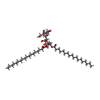
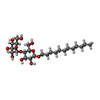

| #28: Sugar | ChemComp-DGD / |
|---|---|
| #30: Sugar | ChemComp-LMT / |
-Non-polymers , 10 types, 901 molecules 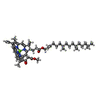
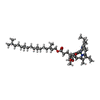
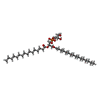
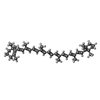
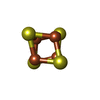








| #21: Chemical | ChemComp-CL0 / | ||||||||||||||||
|---|---|---|---|---|---|---|---|---|---|---|---|---|---|---|---|---|---|
| #22: Chemical | ChemComp-CLA / #23: Chemical | Mass: 454.641 Da / Num. of mol.: 2 / Source method: obtained synthetically / Formula: C29H42O4 / Feature type: SUBJECT OF INVESTIGATION #24: Chemical | ChemComp-LHG / #25: Chemical | ChemComp-BCR / #26: Chemical | #27: Chemical | ChemComp-UNL / Mass: 949.299 Da / Num. of mol.: 52 / Source method: obtained synthetically #29: Chemical | ChemComp-5X6 / Mass: 568.871 Da / Num. of mol.: 30 / Source method: obtained synthetically / Formula: C40H56O2 / Feature type: SUBJECT OF INVESTIGATION #31: Chemical | ChemComp-RRX / ( #32: Water | ChemComp-HOH / | |
-Details
| Has ligand of interest | Y |
|---|---|
| Has protein modification | Y |
-Experimental details
-Experiment
| Experiment | Method: ELECTRON MICROSCOPY |
|---|---|
| EM experiment | Aggregation state: PARTICLE / 3D reconstruction method: single particle reconstruction |
- Sample preparation
Sample preparation
| Component | Name: PSI-LHCI / Type: COMPLEX / Entity ID: #1-#20 / Source: NATURAL | |||||||||||||||
|---|---|---|---|---|---|---|---|---|---|---|---|---|---|---|---|---|
| Molecular weight | Value: 0.68 MDa / Experimental value: NO | |||||||||||||||
| Source (natural) | Organism:  Galdieria sulphuraria (eukaryote) Galdieria sulphuraria (eukaryote) | |||||||||||||||
| Buffer solution | pH: 6.5 | |||||||||||||||
| Buffer component |
| |||||||||||||||
| Specimen | Conc.: 2.5 mg/ml / Embedding applied: NO / Shadowing applied: NO / Staining applied: NO / Vitrification applied: YES | |||||||||||||||
| Specimen support | Grid material: COPPER / Grid mesh size: 300 divisions/in. / Grid type: Quantifoil R1.2/1.3 | |||||||||||||||
| Vitrification | Instrument: FEI VITROBOT MARK IV / Cryogen name: ETHANE / Humidity: 100 % / Chamber temperature: 277 K |
- Electron microscopy imaging
Electron microscopy imaging
| Microscopy | Model: JEOL CRYO ARM 300 |
|---|---|
| Electron gun | Electron source:  FIELD EMISSION GUN / Accelerating voltage: 300 kV / Illumination mode: FLOOD BEAM FIELD EMISSION GUN / Accelerating voltage: 300 kV / Illumination mode: FLOOD BEAM |
| Electron lens | Mode: BRIGHT FIELD / Nominal magnification: 60000 X / Nominal defocus max: 1800 nm / Nominal defocus min: 1200 nm |
| Image recording | Electron dose: 50 e/Å2 / Detector mode: COUNTING / Film or detector model: GATAN K3 (6k x 4k) |
- Processing
Processing
| EM software |
| ||||||||||||||||||||||||||||||||||||||||||||||||||||||||||||||||||||||||||||||||||||||||||||||||||||||||||
|---|---|---|---|---|---|---|---|---|---|---|---|---|---|---|---|---|---|---|---|---|---|---|---|---|---|---|---|---|---|---|---|---|---|---|---|---|---|---|---|---|---|---|---|---|---|---|---|---|---|---|---|---|---|---|---|---|---|---|---|---|---|---|---|---|---|---|---|---|---|---|---|---|---|---|---|---|---|---|---|---|---|---|---|---|---|---|---|---|---|---|---|---|---|---|---|---|---|---|---|---|---|---|---|---|---|---|---|
| CTF correction | Type: PHASE FLIPPING AND AMPLITUDE CORRECTION | ||||||||||||||||||||||||||||||||||||||||||||||||||||||||||||||||||||||||||||||||||||||||||||||||||||||||||
| Particle selection | Num. of particles selected: 2583694 | ||||||||||||||||||||||||||||||||||||||||||||||||||||||||||||||||||||||||||||||||||||||||||||||||||||||||||
| Symmetry | Point symmetry: C1 (asymmetric) | ||||||||||||||||||||||||||||||||||||||||||||||||||||||||||||||||||||||||||||||||||||||||||||||||||||||||||
| 3D reconstruction | Resolution: 2.19 Å / Resolution method: FSC 0.143 CUT-OFF / Num. of particles: 110313 / Symmetry type: POINT | ||||||||||||||||||||||||||||||||||||||||||||||||||||||||||||||||||||||||||||||||||||||||||||||||||||||||||
| Atomic model building | Protocol: FLEXIBLE FIT / Space: RECIPROCAL | ||||||||||||||||||||||||||||||||||||||||||||||||||||||||||||||||||||||||||||||||||||||||||||||||||||||||||
| Atomic model building | Details: Phyre2 server / Source name: Other / Type: in silico model | ||||||||||||||||||||||||||||||||||||||||||||||||||||||||||||||||||||||||||||||||||||||||||||||||||||||||||
| Refinement | Resolution: 2.19→204.54 Å / Cor.coef. Fo:Fc: 0.862 / SU B: 3.851 / SU ML: 0.088 / ESU R: 0.13 Stereochemistry target values: MAXIMUM LIKELIHOOD WITH PHASES Details: HYDROGENS HAVE BEEN USED IF PRESENT IN THE INPUT
| ||||||||||||||||||||||||||||||||||||||||||||||||||||||||||||||||||||||||||||||||||||||||||||||||||||||||||
| Solvent computation | Solvent model: PARAMETERS FOR MASK CACLULATION | ||||||||||||||||||||||||||||||||||||||||||||||||||||||||||||||||||||||||||||||||||||||||||||||||||||||||||
| Displacement parameters | Biso mean: 70.414 Å2 | ||||||||||||||||||||||||||||||||||||||||||||||||||||||||||||||||||||||||||||||||||||||||||||||||||||||||||
| Refinement step | Cycle: 1 / Total: 41435 | ||||||||||||||||||||||||||||||||||||||||||||||||||||||||||||||||||||||||||||||||||||||||||||||||||||||||||
| Refine LS restraints |
|
 Movie
Movie Controller
Controller



 PDBj
PDBj